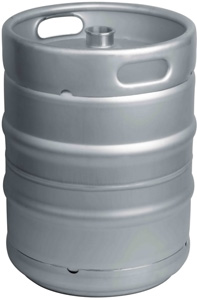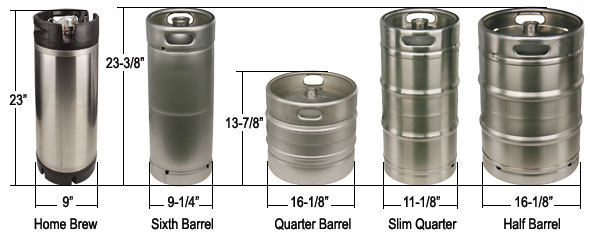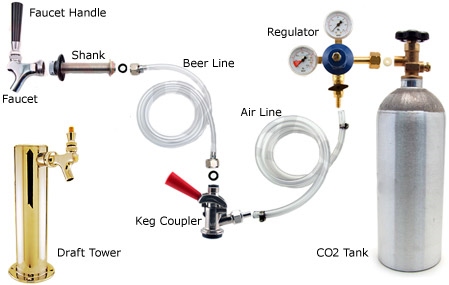Keg beer
Shelf Life
Keg beer will remain fresh if dispensing with CO2, while maintaining the proper temperature and pressure:
- Non-pasteurized draft beer about 45-60 days.
- Pasteurized draft beer about 90-120 days.
Dispensing keg beer with a party pump (air):
- Any draft beer will remain fresh for no more than 8-12 hours.
Air contains oxygen, and oxygen is an enemy of beer. Non-pasteurized beer has a shelf life of 45-60 days. Here is an example of a keg’s life:
- Days 0-10 (Transit / Satellite Warehousing)
- Days 10-20 (Distributor Warehouse / Retail Delivery)
- Days 20-60 (At Tavern)
So the average keg has 25-40 days of shelf life at the tavern.
Pasteurization
Most keg draft beers brewed in the U.S. are not pasteurized during brewing. During the packaging process non-pasteurized draft beers are chilled to the point that the bacteria which ferments the beer becomes dormant.
Temperatures above 38°F will cause non-pasteurized draft beers to foam and promote sour/cloudy beer. Should the temperature of non-pasteurized draft beers rise above 50-55°F, the dormant bacteria which ferments the beer will once again become active, and growth will rapidly begin to spoil flavor and cloud the beer. This is commonly referred to as secondary fermentation.
Most keg draft beers brewed outside the U.S. (Import beers), as well can and bottle beers in the U.S., are heat pasteurized during brewing. This process kills off the bacteria that ferment the beer. Import draft beers can be stored at room temperature and chilled at the point of dispense by use of a flash chiller. However, for logistical reasons, most bars and restaurants keep their import kegs at the same temperature as the domestic kegs.
Dimensions and Capacity
The standard keg size is the half barrel. Specifications for a U.S. 1/2 barrel keg are as follows:
- Height of keg 23.3 inches
- Diameter of keg 16.1–17.15627 inches
- Contents 1984.0 U.S. fluid ounces
- 15.5 U.S. gallons
- 12.91 imp. gallons
- 58.7 liters
- Full keg weight 160.5 pounds (72.8 kg)
- Empty keg weight 29.7 pounds (13.5 kg)
- Beer weight 130.8 pounds (59.3 kg)
- 24×12 fl oz case equivalent 6.9 cases
- 12 fl oz servings 165.333
- 16 fl oz (1 U.S. pint) servings 124
This chart shows various keg sizes and their dimensions:
Installation
Among draught systems, we find three general types based on equipment and design: temporary systems, direct-draw systems and long-draw systems. Draught systems use CO2 alone or mixed with nitrogen in varying proportions depending on the requirements of the system and the beers being served. When properly selected and set, dispense gas maintains the correct carbonation in the beer and helps to preserve its flavor. In most draught systems, the dispense gas also propels beer from the keg to the faucet.
3 components to a draft system:
- Gas
- Beer
- Cooling
The CO2 gas is used to drive beer from the keg, through tubing and to the faucet where it will flow into the customer’s glass. The beer should flow through proper beer lines and avoid any contact with brass parts that would impart a metallic flavor. The beer should flow at a specific rate and arrive with the ideal carbonation level. The key to getting this all right is balance between the applied gas pressure and the resistance provided by the tubing and fixtures the beer passes through during its journey to the bar.
The cooling system should hold beer at a constant temperature from keg to glass. Any change between the temperature of the cooler and the temperature of the beer leaving the faucet leads to dispense problems such as foaming. In a simple direct-draw system a refrigerated cabinet maintains the temperature of the keg and provides cooling to the beer as it travels the short distance to the faucet. Many long-draw systems use a walk-in refrigerator to cool the kegs, plus chilled glycol that circulates in tubes next to the beer lines all the way to the faucet, to ensure that the beer stays cold all the way to the glass.
In a long draw system beer exits the keg through a coupler and usually enters a vinyl beer line. It typically goes about six ft. before connecting to a wall bracket which serves as a transition to specialized barrier tubing. Designed for minimum resistance and superior cleanliness, barrier tubing should carry beer most of the distance from keg to faucet in long-draw systems. Most draught towers use stainless steel tubing to carry the beer to the faucet. In addition, many systems install some length of narrow-gauge vinyl tubing called “choker” between the end of the barrier tubing and the stainless steel tubing of the draught tower, to provide a way to accurately balance the system.


